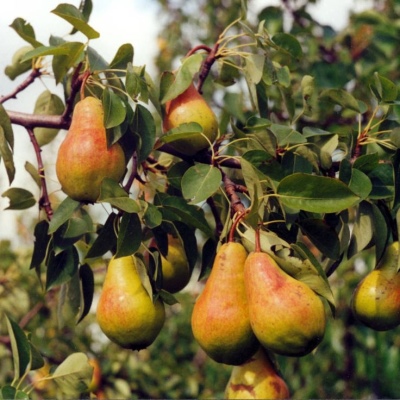
- Fruit weight, g: up to 180
- Ripening terms: summer
- Fruit picking time: end of August
- Appointment: fresh, for preservation
- Growth type: medium height
- Yield: high
- Height, m: 2,5
- Crown: pyramidal
- Escapes: dark brown
- Leaves: smooth, short-pointed, light green in color
The pear variety Pribaltiyskaya oily has been invariably popular among gardeners for several decades. This is not surprising, because its fruits are high-yielding and have a delicate taste, and the trees are frost-hardy and not susceptible to many diseases.
Description of the variety
The Baltic oily pear looks like a medium-sized tree with a powerful root system, reaching up to 2.5 m in height. The branches are even and constantly raised upward, as a result of which the fast-growing crown has a pyramidal shape. The shoots of this variety are dark brown in color. Leaves are smooth, short-pointed in shape, light green in color. The flowering process takes place in June, the flowers are white with rounded petals, odorless.
Fruit characteristics
The Pribaltiyskaya Oily variety is characterized by pear-shaped fruits weighing about 180 g. They have a yellowish-green color with a slight orange tan. The length of the pear reaches 10 cm, and the diameter is 5 cm. It should be noted that the fruits can be stored for no more than two weeks.
Taste qualities
Pears of this variety are tender and juicy. The pulp has a semi-oily structure. The fruit is pleasant to the taste, with a sour sweetness. They are characterized by a thin, smooth leathery shell. They are especially good fresh, but are also used for winter preservation.
Ripening and fruiting
Baltic oily has a summer ripening period. Basically, the mass harvesting of fruits takes place at the end of August. Fruiting occurs in the 5-6th year of growth. Ripe fruits can hang on branches for a long time without crumbling.

Yield
The variety has consistently high yields. The average yield is 60 kg per tree. Baltic oily is famous for its regular annual fruiting.
Landing
For pears of the Pribaltiyskaya oily variety, light, loose and very fertile soil is ideal. The reaction is preferably neutral (pH 6.8-7.0). The landing site should be illuminated by sunlight all day. On the site intended for the cultivation of the Baltic oily pear, there should be no stagnation of melt and rainwater.
Ideally, it is better to take two-year-old seedlings, about 80 cm in height, the bark should look smooth, elastic and not dry. They are planted in late March or mid-November before the start of the active growing season. When planting in spring, a 60x60 pit is prepared in the fall, applying 25 g of manure, 350 g of sand and 90 g of potassium chloride as fertilizer. In the process of planting, you need to carefully spread the roots, place them in a hole and sprinkle them with earth. Then the seedling should be watered abundantly and carefully tamp the earth around it.


Growing and care
Pribaltiyskaya oily pear does not require special conditions for normal growth, it tolerates winter frosts well. It is a self-fertile variety that does not need pollinator planting. In hot summer weather, the tree needs to be watered with 10 liters of water every 3 days. Peat and humus are often used as mulch in a layer of up to 10 cm. Like many fruit trees, this variety requires regular pruning of thick and diseased branches in spring or autumn at temperatures above -7 degrees.



Disease and pest resistance
The Baltic oily pear variety has a high resistance to diseases. In order to prevent fruit rot, scab and mosaic disease, it is necessary to treat trees with a solution of copper sulfate (60-90 g per 10 liters of water) and remove suspicious-looking leaves and fruits in time. Often, young seedlings are attacked by insect pests, the most common of which are leaf rollers, ticks, moths, green apple aphids. For prophylaxis, treatment with Bordeaux liquid, a solution of soap or mustard infusion is recommended, and for the fight, fungicides "Horus" or "Abiga-Peak" are used.

Like any other fruit trees, the pear needs protection from various diseases and pests. When planting a pear on your site, you need to know in advance what diseases you should beware of. To successfully carry out the struggle, it is necessary first to correctly identify the cause of the problem. It is important to distinguish signs of disease from manifestations of the presence of insects, mites, caterpillars and other types of pests.





































































